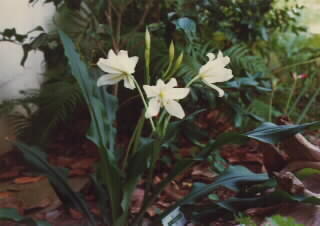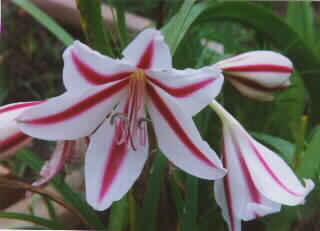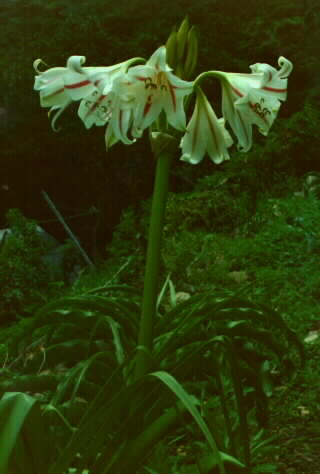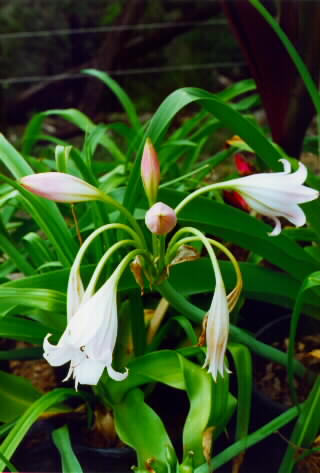 Fig. 42: Crinum jagus: (ex C. giganteum).
There are innumerable variants of the C. jagus: scattered across
Tropical Africa and found as long-established escapes in central and
tropical South America. The swamp forms often have broad foliage while
the drier savanna forms usually have more erect sabre-like foliage. Many
are quite fragrant, but breeders have found the plants disinclined to
outcross. Only one or two known hybrids exist. We show a number of forms
since written or verbal descriptions cannot convey the distinctions commonly
encountered blossomwise.
Fig. 42: Crinum jagus: (ex C. giganteum).
There are innumerable variants of the C. jagus: scattered across
Tropical Africa and found as long-established escapes in central and
tropical South America. The swamp forms often have broad foliage while
the drier savanna forms usually have more erect sabre-like foliage. Many
are quite fragrant, but breeders have found the plants disinclined to
outcross. Only one or two known hybrids exist. We show a number of forms
since written or verbal descriptions cannot convey the distinctions commonly
encountered blossomwise.
|
 Fig. 43: C. jagus var. scillifolia with erect
foliage. This species is adapted to drier areas and is a good garden
plant.
Fig. 43: C. jagus var. scillifolia with erect
foliage. This species is adapted to drier areas and is a good garden
plant.
|
 Fig. 44: C. jagus var noble: with channeled
foliage.
Fig. 44: C. jagus var noble: with channeled
foliage.
|
 Fig. 45: C. jagus var. vanillodorum with broad
wavy foliage. This is a swamp plant.
Fig. 45: C. jagus var. vanillodorum with broad
wavy foliage. This is a swamp plant.
|
 Fig. 46: C. jagus var. rattrayii with quite rigid erect
foliage. Native to the Great Rift area and suitable to dry locations.
Fig. 46: C. jagus var. rattrayii with quite rigid erect
foliage. Native to the Great Rift area and suitable to dry locations.
|
 Fig. 47: Another example of C. jagus var rattrayii
blossoms.
Fig. 47: Another example of C. jagus var rattrayii
blossoms.
|
 Fig. 48: A C. jagus variant noted at the Fairchild Gardens.
Fig. 48: A C. jagus variant noted at the Fairchild Gardens.
|
 Fig. 49: Crinum scabrum Herbert. In 1833 William Herbert named
an exotic Crinum received from Brazil, the C. scabrum,
not knowing the bulb was Tropical African. This is the Brazilian exotic which
compares closely with Herbert's holotype illustration. We thank Willem Reuter
for this most informative photograph. Many geographical variants and genetic forms exist
since the plants are scattered over some 5,000 miles of tropical Africa from
Sierra Leone to Ethiopia. Herbert recognized C. scabrum as a member of
his series Ornatae, a distinct tropical group.
Fig. 49: Crinum scabrum Herbert. In 1833 William Herbert named
an exotic Crinum received from Brazil, the C. scabrum,
not knowing the bulb was Tropical African. This is the Brazilian exotic which
compares closely with Herbert's holotype illustration. We thank Willem Reuter
for this most informative photograph. Many geographical variants and genetic forms exist
since the plants are scattered over some 5,000 miles of tropical Africa from
Sierra Leone to Ethiopia. Herbert recognized C. scabrum as a member of
his series Ornatae, a distinct tropical group.
|
 Fig. 50: A C. scabrum variant, sometimes identified as
C. sanderianum Baker (C. ornatum Bury Hexandria plantae. t.18,
1834) and similar to Ehret's 1748 illustration of
Lillium narcessus africanus from Gulf Coast, Ghana.
Fig. 50: A C. scabrum variant, sometimes identified as
C. sanderianum Baker (C. ornatum Bury Hexandria plantae. t.18,
1834) and similar to Ehret's 1748 illustration of
Lillium narcessus africanus from Gulf Coast, Ghana.
|
 Fig. 51: A C. scabrum intraspecific cross. Mrs. D. C.
Sheppard has been quite successful in intercrossing various C. scabrum
forms and the second generation have indicated considerable diversity and
vigor. All have promise as breeding stock since they have quantities of seed.
Fig. 51: A C. scabrum intraspecific cross. Mrs. D. C.
Sheppard has been quite successful in intercrossing various C. scabrum
forms and the second generation have indicated considerable diversity and
vigor. All have promise as breeding stock since they have quantities of seed.
|
 Fig. 52: Crinum fimbriatulum Baker. This is an
inland Angolan form previously identified as C. kirckii by Verdoorn.
Photo by Gordon McNeil. This form is closely allied to C. scabrum.
A related form in Chad and the Congo is inclined to have more cernuous blossoms.
Fig. 52: Crinum fimbriatulum Baker. This is an
inland Angolan form previously identified as C. kirckii by Verdoorn.
Photo by Gordon McNeil. This form is closely allied to C. scabrum.
A related form in Chad and the Congo is inclined to have more cernuous blossoms.
|
 Fig. 53: A photo identified as C. verdoorniae by
the late Gordon McNeil, but apparently is C. fimbriatulum.
Fig. 53: A photo identified as C. verdoorniae by
the late Gordon McNeil, but apparently is C. fimbriatulum.
|
 Fig. 54: Recently identified as a 4-flowered Congo Crinum species allied to Crinum nubicum (Chev.) L. S. Hannibal
(ex C. humilis Chev. non Herb.), native to Zaire (Congo). Others
are found throughout
the tropics from Chad and down into south central Africa. These small
two-flowered Crinum are related to C. distichum Herb., or
A. ornatum Aiton (Syn. C. brousonetii sensu Herb.) and
represented by Kew specimens. This is a a unique genetic race. Several
forms have their umbels subsurface like C. acule Baker. Recently
F. N. Hepper decided that C. scabrum and all allied tropical forms
were a single common species: namely C. ornatum (Aiton) Bury, with
the original A. ornata Aiton specimen as the holotype. For plant
breeders this lumping rather confuses the issue since their various
crossings indicate specific types which best be identified by their classical
names.
Fig. 54: Recently identified as a 4-flowered Congo Crinum species allied to Crinum nubicum (Chev.) L. S. Hannibal
(ex C. humilis Chev. non Herb.), native to Zaire (Congo). Others
are found throughout
the tropics from Chad and down into south central Africa. These small
two-flowered Crinum are related to C. distichum Herb., or
A. ornatum Aiton (Syn. C. brousonetii sensu Herb.) and
represented by Kew specimens. This is a a unique genetic race. Several
forms have their umbels subsurface like C. acule Baker. Recently
F. N. Hepper decided that C. scabrum and all allied tropical forms
were a single common species: namely C. ornatum (Aiton) Bury, with
the original A. ornata Aiton specimen as the holotype. For plant
breeders this lumping rather confuses the issue since their various
crossings indicate specific types which best be identified by their classical
names.
|
 Fig. 55: Crinum abyssinicum, also a sessile flowered Ornatae member,
was first introduced to California by Luther Burbank. Several variants have
been collected since. I have three which for genetic distinctions fail to
cross, but will outcross with other members of the series. Crinum
schimperi, a larger form, is closely allied, as as is C. album
(ex C. yemense) and the humid tropical C. scabrum
and C. zeylanicum. Since C. abysinnicum is a high semi-desert
form, it, like C. schimperi, is well adapted to the dry summers of
California and is a good breeder. A number of hybrids have viable pollen,
like 'Peach Blow', a cross with C. americanum.
Fig. 55: Crinum abyssinicum, also a sessile flowered Ornatae member,
was first introduced to California by Luther Burbank. Several variants have
been collected since. I have three which for genetic distinctions fail to
cross, but will outcross with other members of the series. Crinum
schimperi, a larger form, is closely allied, as as is C. album
(ex C. yemense) and the humid tropical C. scabrum
and C. zeylanicum. Since C. abysinnicum is a high semi-desert
form, it, like C. schimperi, is well adapted to the dry summers of
California and is a good breeder. A number of hybrids have viable pollen,
like 'Peach Blow', a cross with C. americanum.
|
 Fig. 56: Crinum latifolium (L.) L., a member of the
series Ornatae, is native to India and Sri Lanka. There are several closely
related forms like C. latifolium, C. careyanum, and C.
herbertianum. All are good breeders but strictly tropical, thus their
hybrids need winter protection in case of frosts. Photo by D. H. Nicolson.
Fig. 56: Crinum latifolium (L.) L., a member of the
series Ornatae, is native to India and Sri Lanka. There are several closely
related forms like C. latifolium, C. careyanum, and C.
herbertianum. All are good breeders but strictly tropical, thus their
hybrids need winter protection in case of frosts. Photo by D. H. Nicolson.
|
 Fig. 57: C. zeylanicum, a closely allied species,
as noted, J. D. Hooker classed C. zeylanicum, C. careyanum,
C. moluccanum, C. speciosum, and other allied asian forms
all as C. latifolium, all due to their close inter-relationship.
Many of his specimens are filed in the British Museum under
C. latifolium.
Fig. 57: C. zeylanicum, a closely allied species,
as noted, J. D. Hooker classed C. zeylanicum, C. careyanum,
C. moluccanum, C. speciosum, and other allied asian forms
all as C. latifolium, all due to their close inter-relationship.
Many of his specimens are filed in the British Museum under
C. latifolium.
|
 Fig. 58: Crinum graminicola Verdoorn, and a number
of associated forms are found about the grasslands of the Mid and North
Transvaal. Gordon McNeil had quite a collection of native Crinum. We
attempted to have his garden recognized as a national heritage, but his
property is now part of a native reserve, and the natives are inclined to
use all bulbs for medicinal purposes, whether beneficial or toxic.
Fig. 58: Crinum graminicola Verdoorn, and a number
of associated forms are found about the grasslands of the Mid and North
Transvaal. Gordon McNeil had quite a collection of native Crinum. We
attempted to have his garden recognized as a national heritage, but his
property is now part of a native reserve, and the natives are inclined to
use all bulbs for medicinal purposes, whether beneficial or toxic.
|
 Fig. 59: Identified by Gordon as a C. graminicola
variant which is common to the Chobe River area near the Zambian border. No name is
available and the bulb is not in circulation.
Fig. 59: Identified by Gordon as a C. graminicola
variant which is common to the Chobe River area near the Zambian border. No name is
available and the bulb is not in circulation.
|
 Fig. 60: Another Chobe River unknown species collected by G. McNeil.
Fig. 60: Another Chobe River unknown species collected by G. McNeil.
|
 Fig. 61: A species identified as near the lost C. delagoense,
also collected by G. McNeil along the Chobe River.
This species is reportedly quite variable and may be allied to
C. delagoense which seems fairly adaptive to garden use.
Fig. 61: A species identified as near the lost C. delagoense,
also collected by G. McNeil along the Chobe River.
This species is reportedly quite variable and may be allied to
C. delagoense which seems fairly adaptive to garden use.
|
 Fig. 33: Crinum macowanii: One of the numerous
geographical variants found scattered from the Congo down to the south-eastern
portion of Cape Province. Some forms are tetraploids and have been crossed
with the Orange River hexaploid C. bulbispermumi, giving immense
hybrids.
Fig. 33: Crinum macowanii: One of the numerous
geographical variants found scattered from the Congo down to the south-eastern
portion of Cape Province. Some forms are tetraploids and have been crossed
with the Orange River hexaploid C. bulbispermumi, giving immense
hybrids.
 Fig. 34: C. macowanii variant. Many variations
exist, some with pure white fairly compact blossoms to those with red
keels, and widely expanded petals. Some buds suggest partially
inflated balloons.
Fig. 34: C. macowanii variant. Many variations
exist, some with pure white fairly compact blossoms to those with red
keels, and widely expanded petals. Some buds suggest partially
inflated balloons.
 Fig. 35: C. macowanii variant.
Fig. 35: C. macowanii variant.
 Fig. 36: Crinum bulbispermum variabilis. Excluding some
two-flowered Crinum species, all subtropical Codonocrinum subgenera forms have
pedicellated blossoms which flower sequentially one to three days apart.
This bulb was collected in 1938 along the Orange River by Dr. Rhodin
from U. C. Berkeley. It is a hexaploid. 'Cape Dawn' is its hybrid
with C. macowanii above.
Fig. 36: Crinum bulbispermum variabilis. Excluding some
two-flowered Crinum species, all subtropical Codonocrinum subgenera forms have
pedicellated blossoms which flower sequentially one to three days apart.
This bulb was collected in 1938 along the Orange River by Dr. Rhodin
from U. C. Berkeley. It is a hexaploid. 'Cape Dawn' is its hybrid
with C. macowanii above.
 Fig. 37: A C. bulbispermum variant. This hexaploid
form grows along the Orange River in South Africa.
Fig. 37: A C. bulbispermum variant. This hexaploid
form grows along the Orange River in South Africa.
 Fig. 38: Another C. bulbispermum variabilis, which
changes color with age. Some tetraploid forms seemingly exist, but their
hybrids take years to mature, and give no offsets. Propagation is by
bulb cuttage.
Fig. 38: Another C. bulbispermum variabilis, which
changes color with age. Some tetraploid forms seemingly exist, but their
hybrids take years to mature, and give no offsets. Propagation is by
bulb cuttage.
 Fig. 39: Crinum moorei Hooker. A Natal (now KwaZulu)
species commonly grown in Californian gardens. It requires part shade and
will outcross with other species, but is prone to mislead one by its
inclination to produce maternal apogamic seed, so use it as a pollen parent.
Some tetraploid forms exist. Greg Rettit reports having ten distinct
forms.
Fig. 39: Crinum moorei Hooker. A Natal (now KwaZulu)
species commonly grown in Californian gardens. It requires part shade and
will outcross with other species, but is prone to mislead one by its
inclination to produce maternal apogamic seed, so use it as a pollen parent.
Some tetraploid forms exist. Greg Rettit reports having ten distinct
forms.
 Fig. 40: Crinum moorei var. schmidtii: An all white
pigment-free variant which has a unique bified stigma which confirms identity. It is genetically distinct from the common C. moorei forms but will outcross with some other Crinum forms.
Fig. 40: Crinum moorei var. schmidtii: An all white
pigment-free variant which has a unique bified stigma which confirms identity. It is genetically distinct from the common C. moorei forms but will outcross with some other Crinum forms.
 Fig. 41: Another C. moorei var. schmidtii example: A typical broad petal form.
Fig. 41: Another C. moorei var. schmidtii example: A typical broad petal form.



















